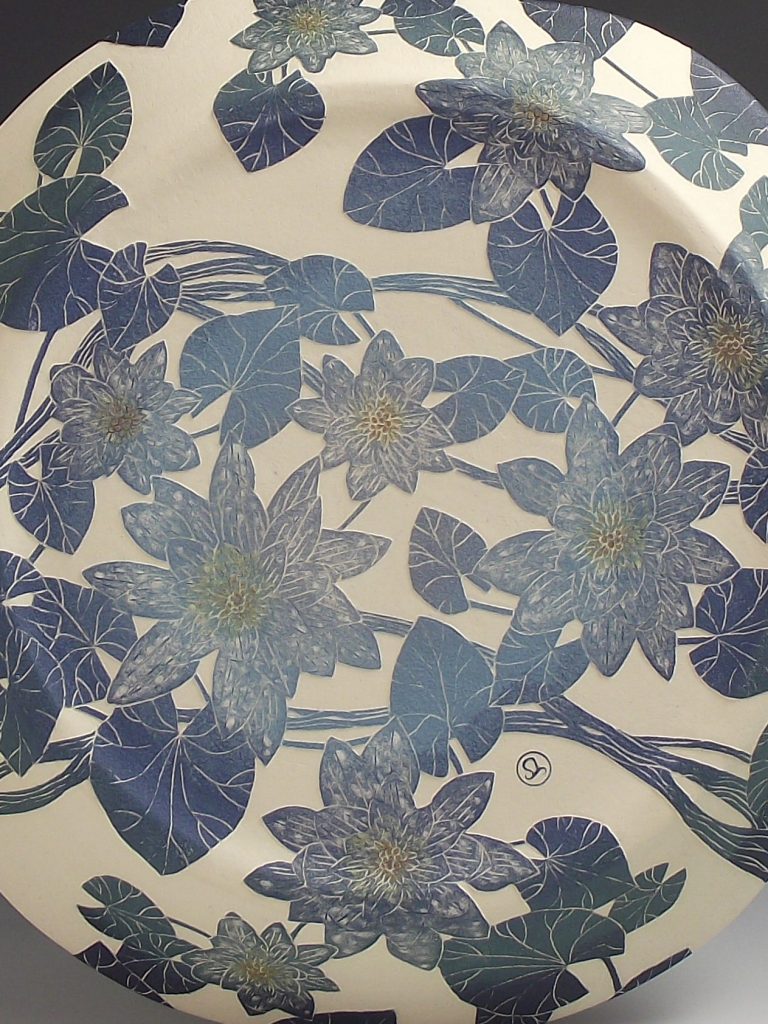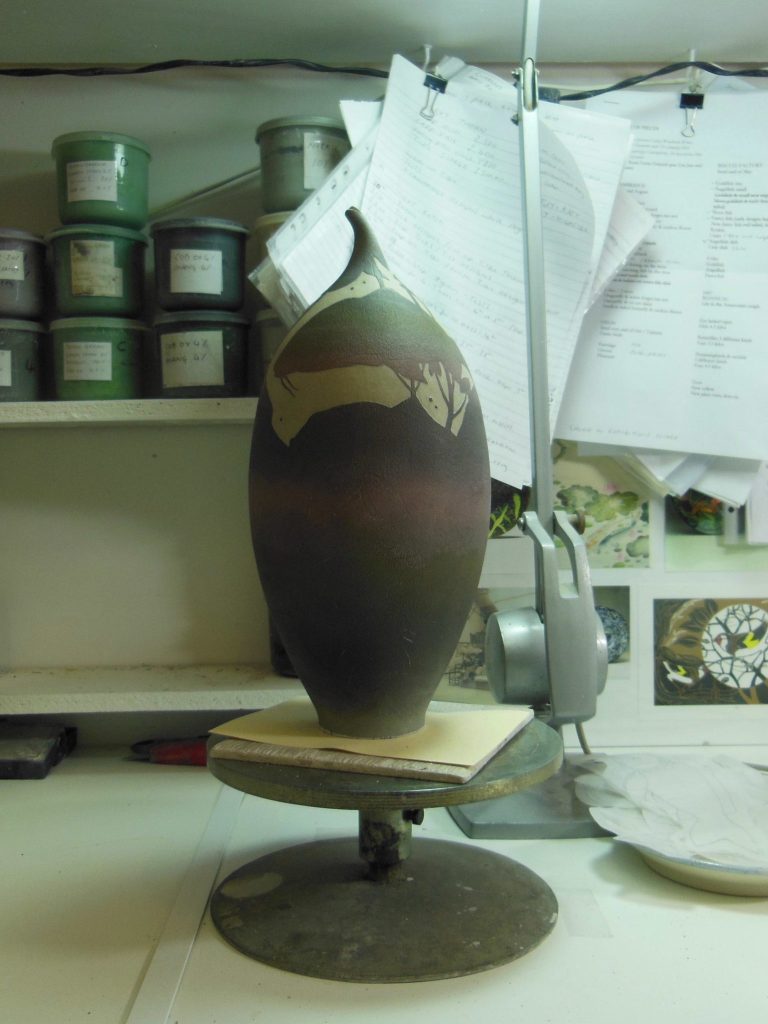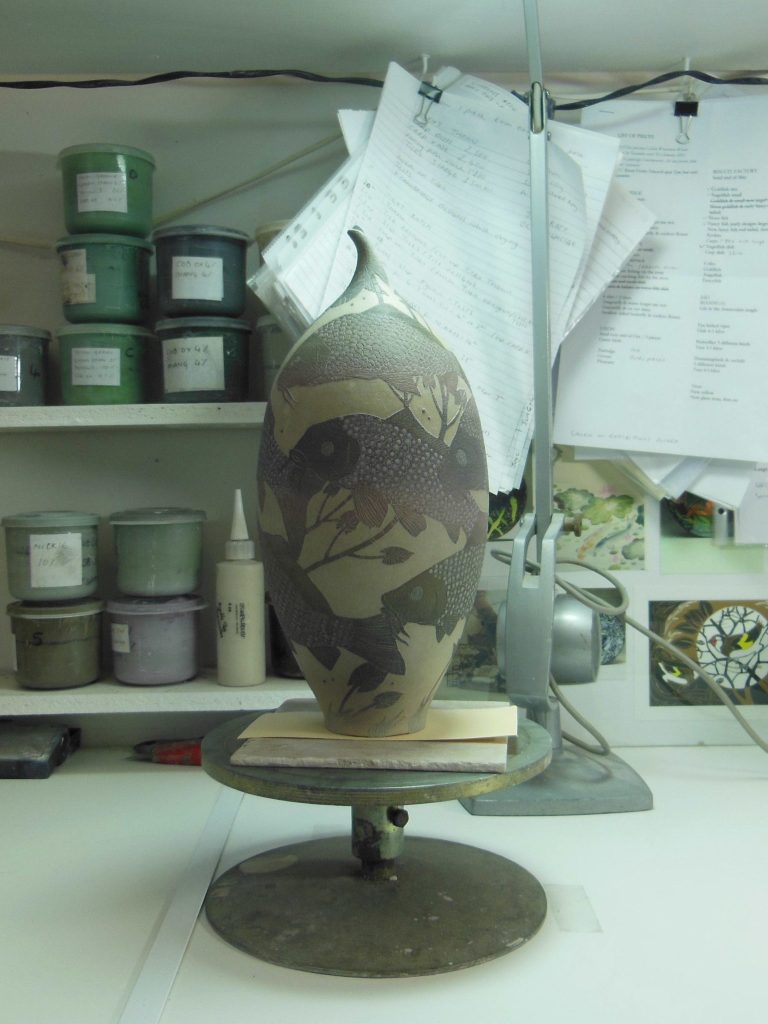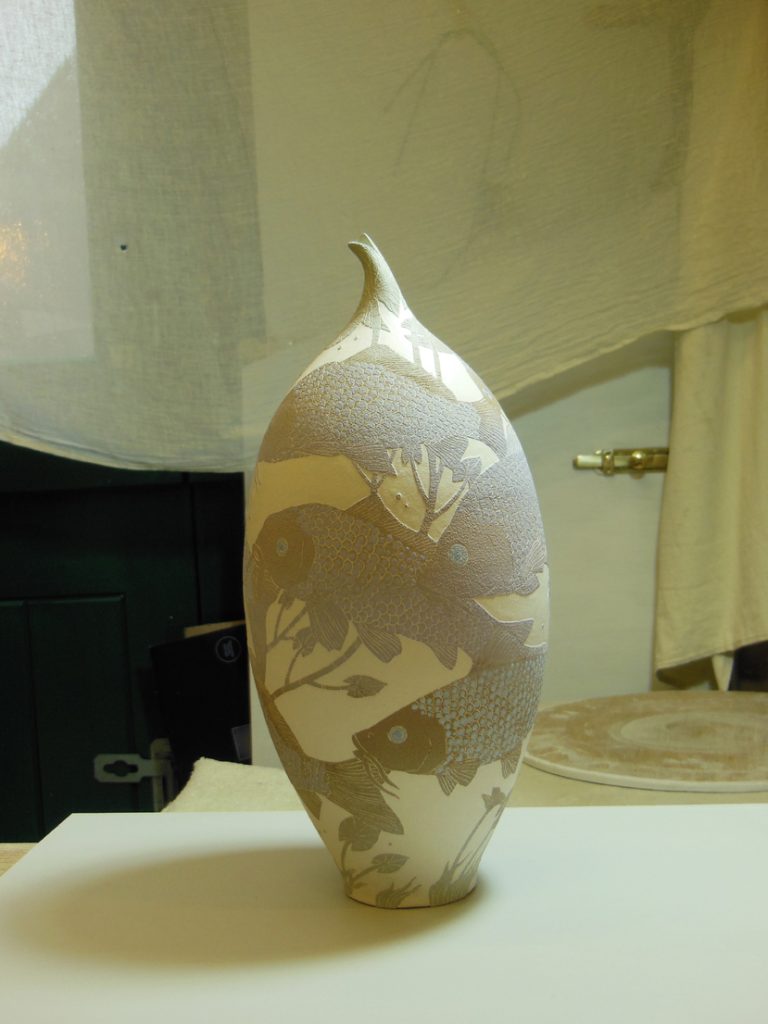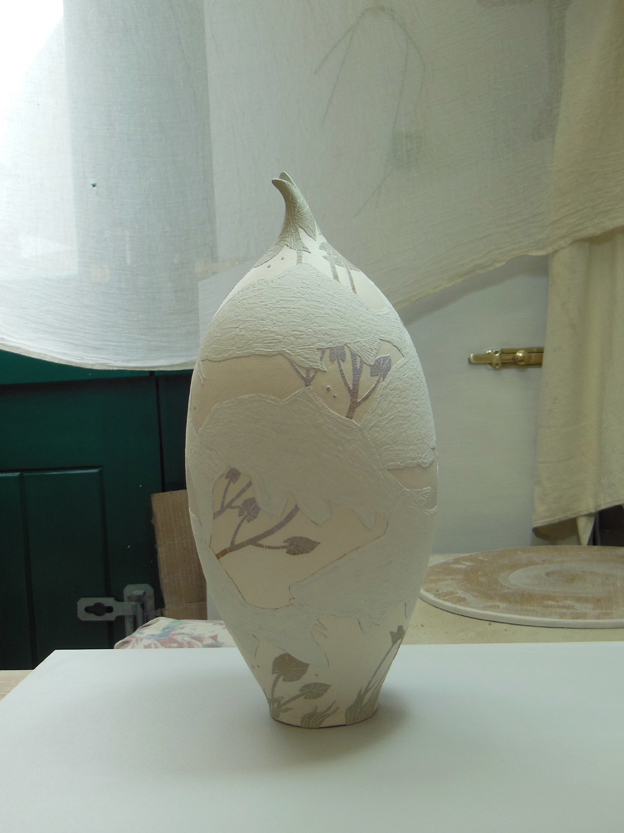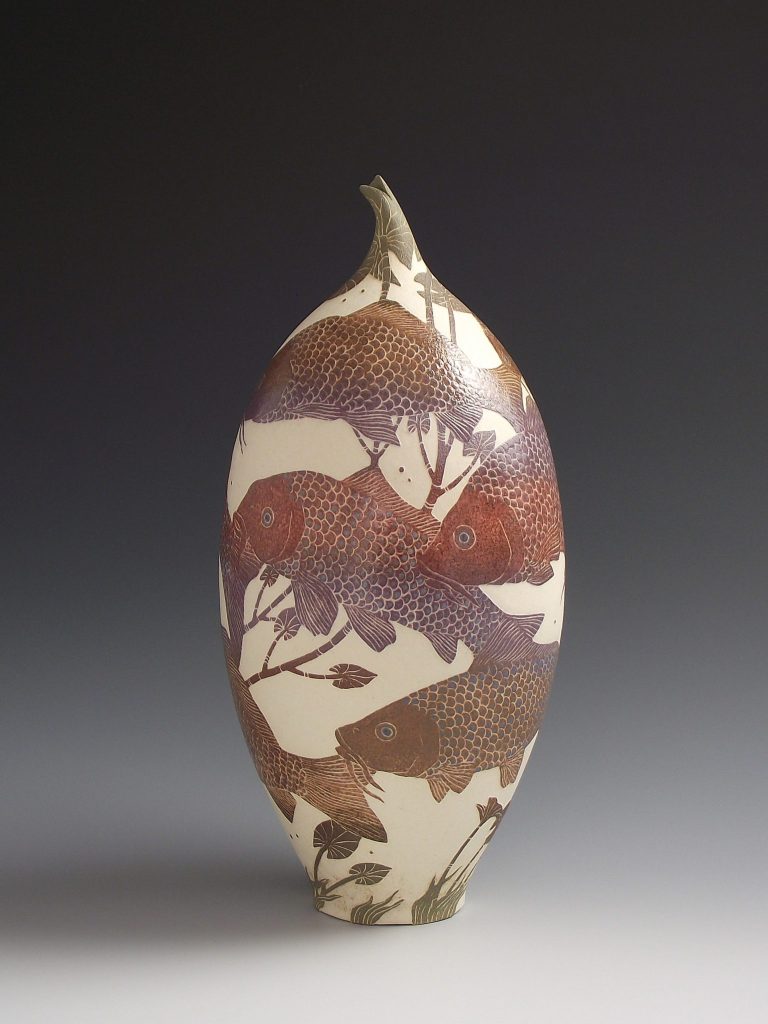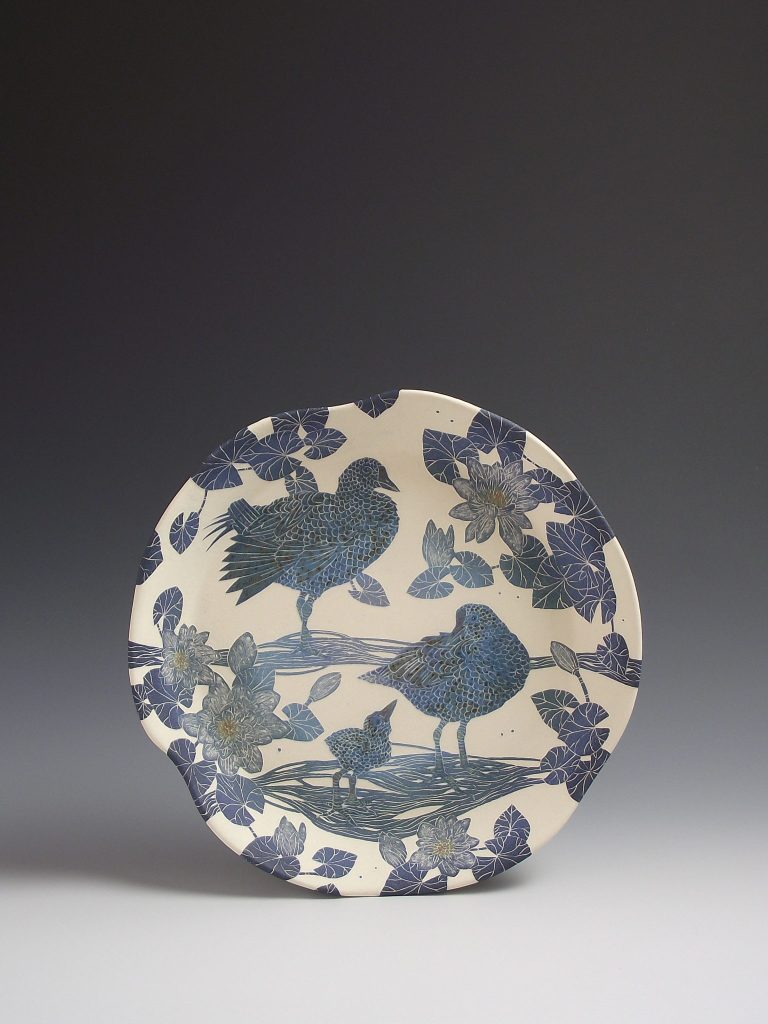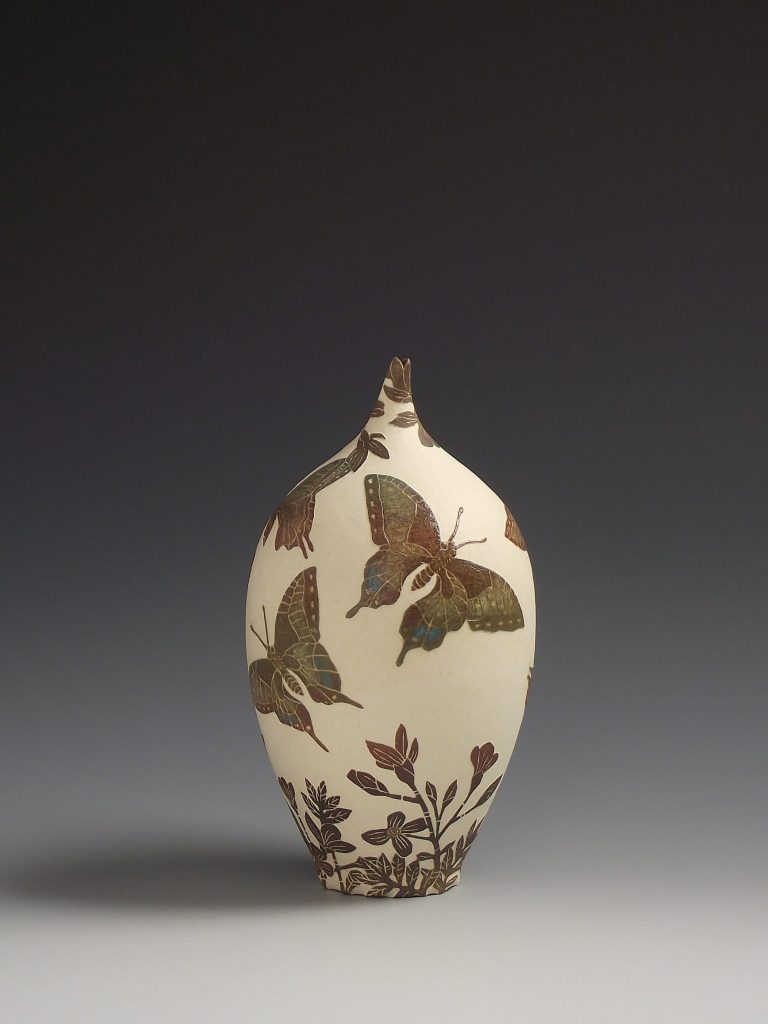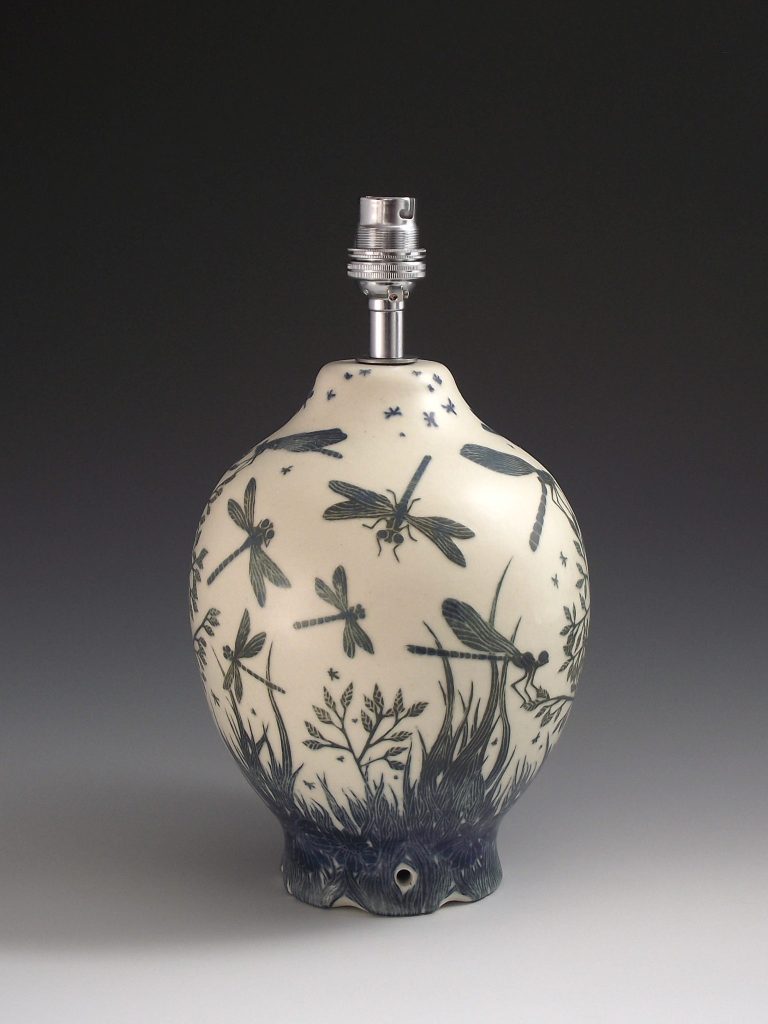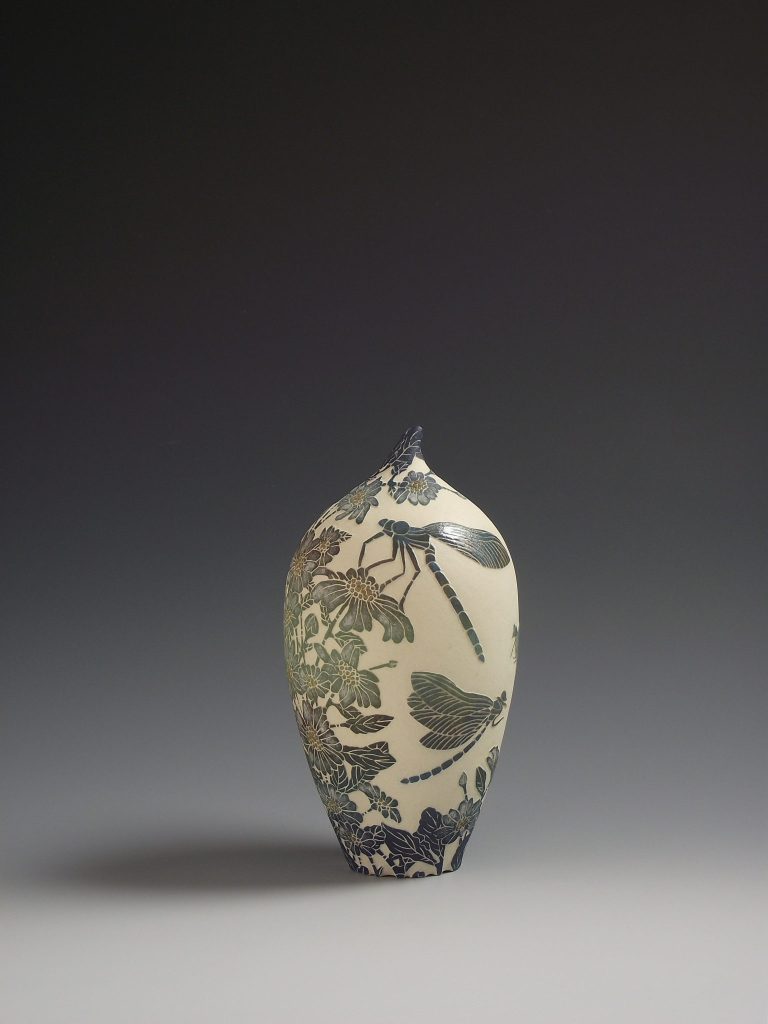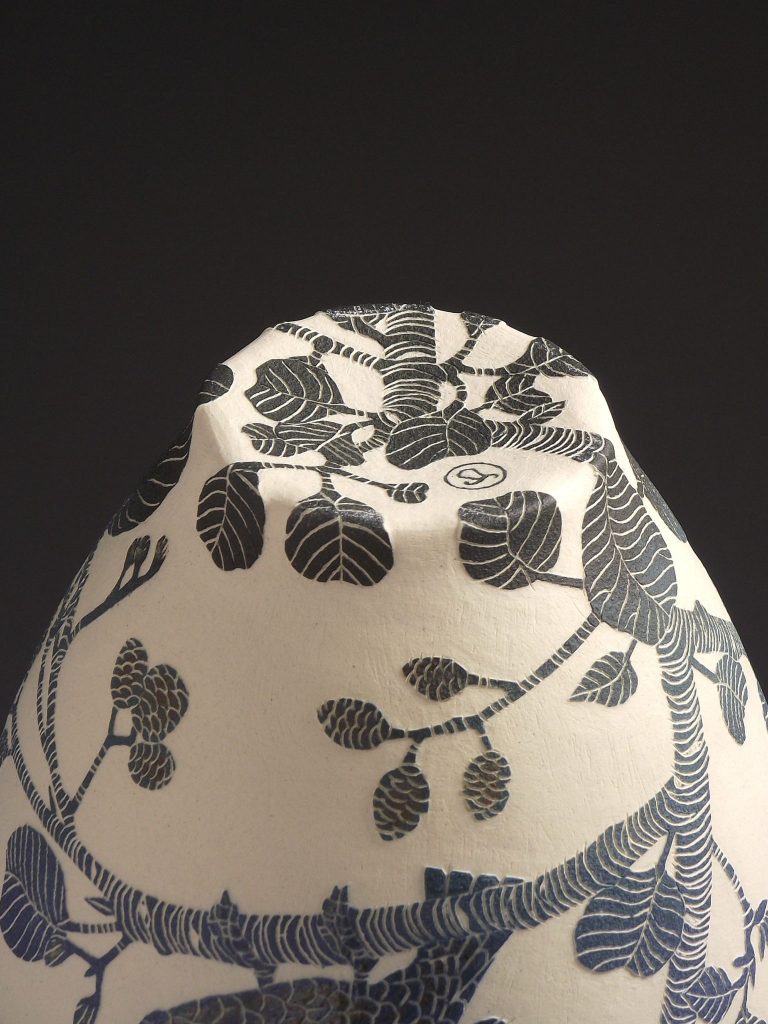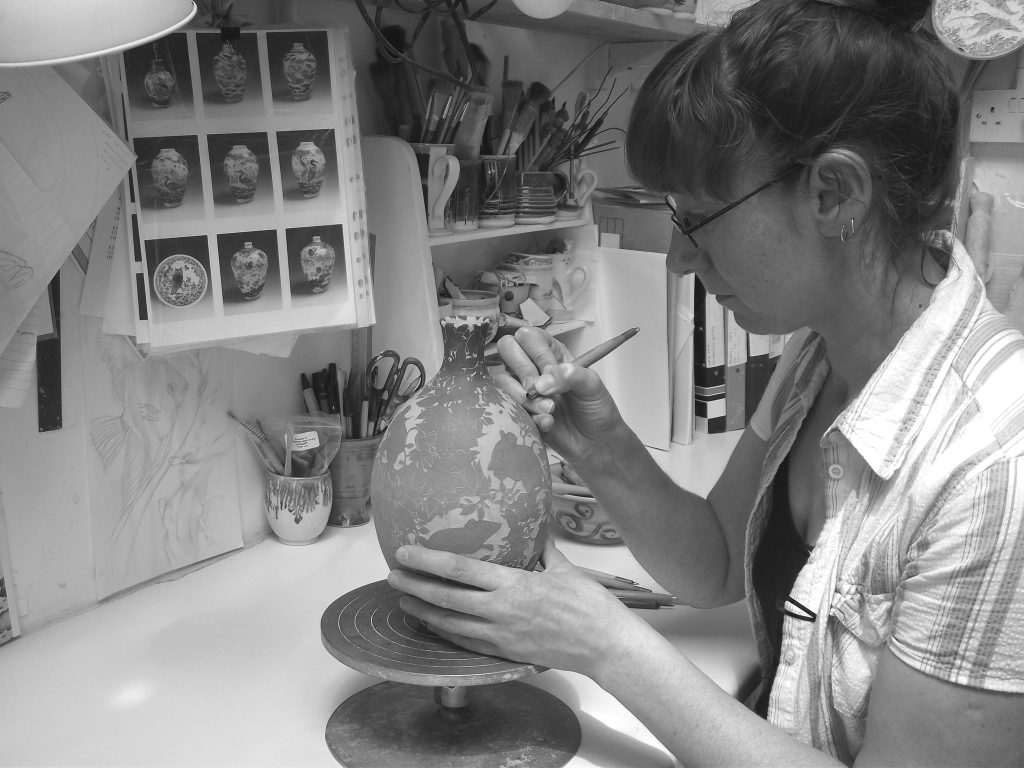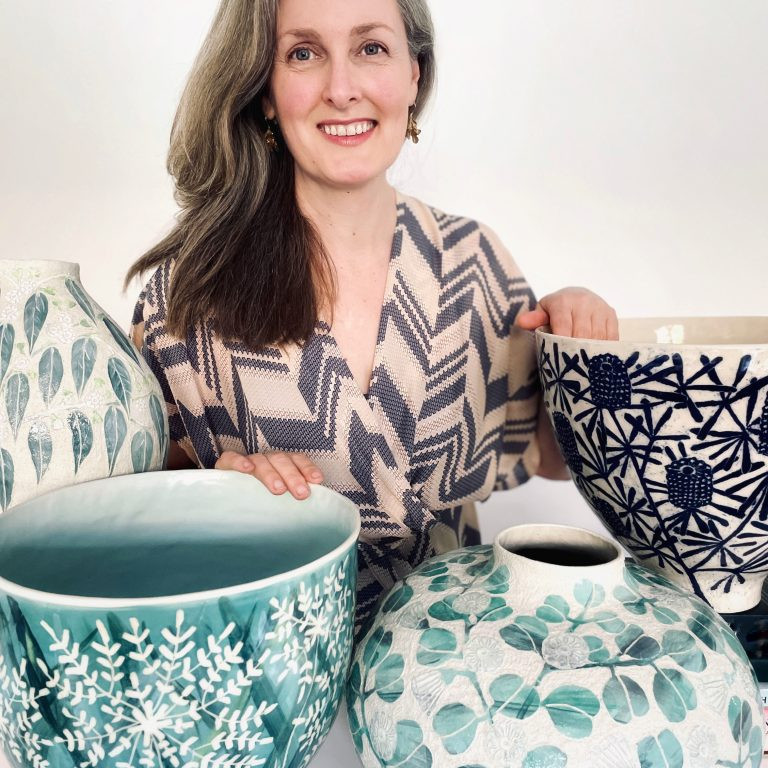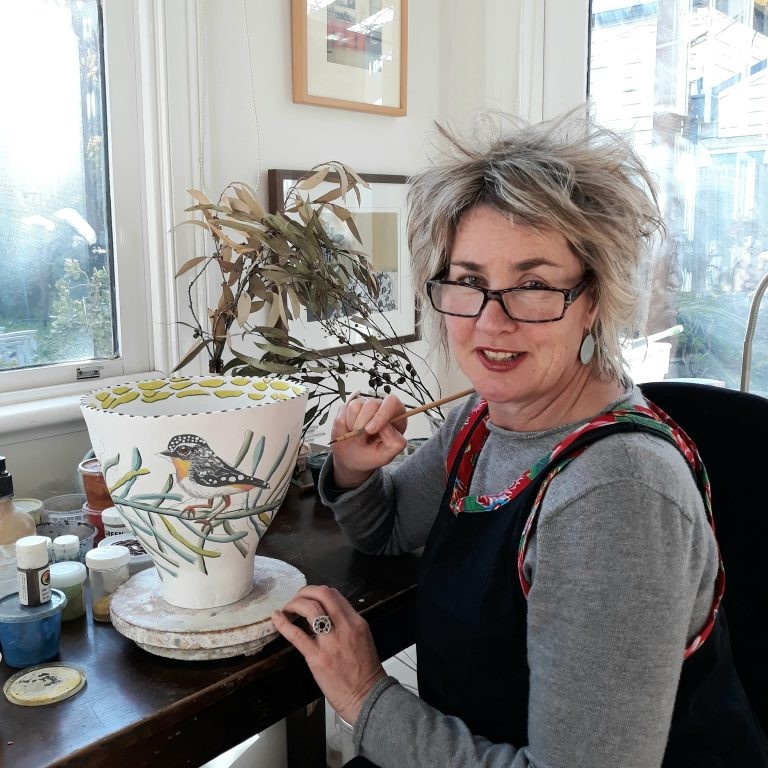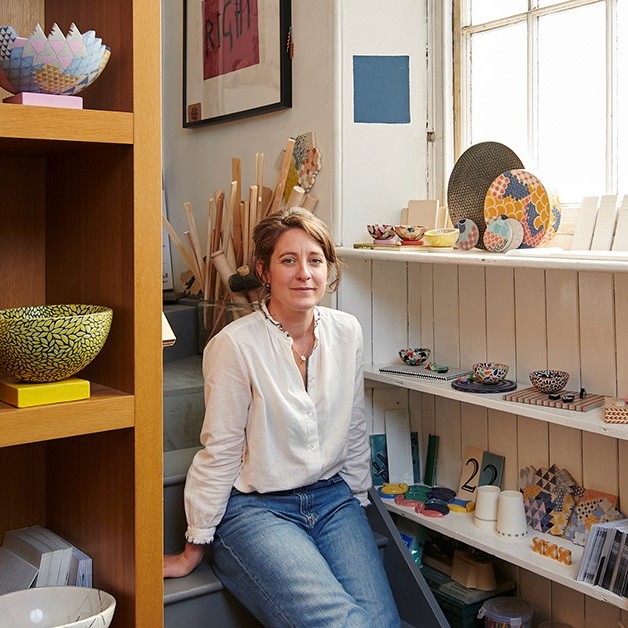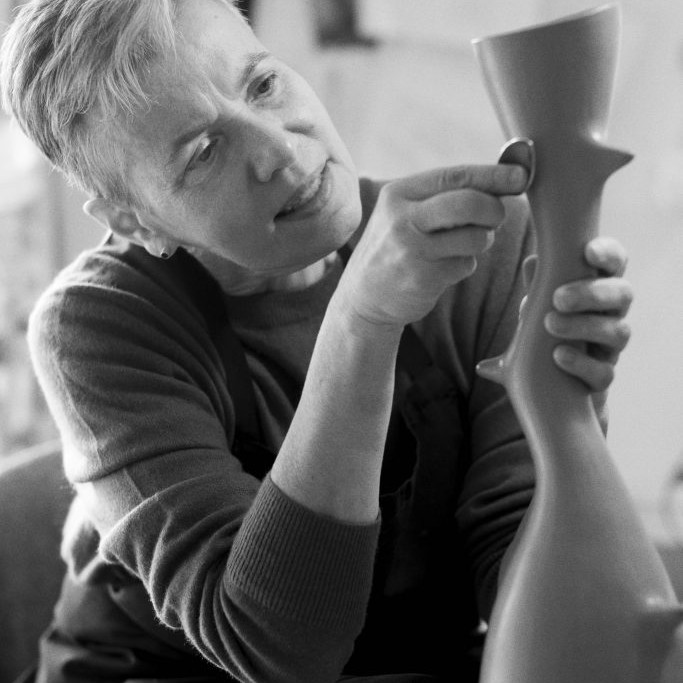Tiffany Scull Ceramic Artist
Discuss your work in relation to Art Nouveau movement?
I feel a strong connection visually to Art Nouveau in relation to the way I use the natural world and movement in my work. I depict birds, fish and insects in a stylised graphic representation and some of my designs look to me as though they could be wall paper or fabric prints. The forms are connected to the decoration picking up on the way that a plant grows or the flow of water. My work has evolved over time and at no point have I ever copied any Nouveau designs, in fact I have been very careful not to.
Moorhen and Water Lily dish, detail, 29cms, Sgraffito
Can you explain the actual technique involved in Sgraffito?
Once I have chosen a theme for my next collection I make detailed pencil drawings of images I like, always making sure I place the animal chosen in the correct habitat they live in. After I have thrown and turned my forms I choose which drawings to use and a tracing is made. The leather hard form is covered with coloured slip and left until touch dry. I make an imprint of the outline onto the clay surface using the tracing and a blunt tool. I place the main themes of the design first building up from there.
Kingfisher and Minnow, Vessel 27cm high, Dried form before firing,
Ceramic form decorated with Sgraffito
MY SGRAFFITO PROCESS
Once I have mapped out the decoration I take a sharp thin tool and draw the outline through the slip to the clay body. After all the out lines are drawn I take away the slip between the drawings to reveal the white clay. I use a selection of blades to create a smooth finish.
Once all the cutting away is complete I add extra contrasting slip colour and draw on the final details. Each piece is then left to dry very slowly before the two firings.
After the first bisque I brush a clear glaze onto the main themes leaving the rest of the piece matt.
The final glaze firing is 1180°c in an electric kiln.
Here is step by step images of the process…
How did you learn this technique?
I discovered the technique of Sgraffito whilst working with a friend at her gallery and pottery. I came across some slips and remembered how I enjoyed using them at Art College. I brushed some blue slip onto a leather hard plate and began to draw a pattern with a pointed tool. From that moment on I was totally hooked. It wasn’t until much later I found out what the technique was actually called. Up until this point I had always seen my ceramics and drawing as two different aspects to my art. I realised that Sgraffito would allow me to combine the two and I still have that excitement today.
Moorhen and Water-lily Dish, 26 cm,
Recently you have been working on new pieces can you expand on these new pieces and the design aspect?
I have recently gone through several changes in my work and they are all inter-connected
I cut my Sgraffito in deeper creating a three dimensional feel and continued the design all the way around the form. By only glazing the main themes of each piece I used the chemical change between the glazed and unglazed slips to create extra depth and contrast to the colours. I introduced more movement by undulating the edge of dishes and slightly bending the necks of vessels, fully connecting decoration and form. I opened up the designs showing more white clay body and the birds and fish were drawn on larger allowing me to add more contrasting slips and detail. I am very happy with the tension that the matt and shiny surface creates and have ideas for combining several different glazes on one design.
I am currently in the process of creating two very large pieces decorated with Birds of Paradise. This project has been more difficult to get started than I ever imagined as I have had to contact several organizations to check tree and Orchid varieties I have chosen. It’s very important for continuity that I place the correct birds with the right trees that grow in the forests at high altitudes in Papua New Guinea.
Discuss how you have worked on make larger pieces and the difficulties you have to face when working on larger pieces?
The main difficulty I face decorating larger pieces is keeping them damp enough to work on. I have started to use wet strips of paper stuck onto my sgraffito while I’m working to keep the dampness in and protecting the decoration. Large dishes are more challenging to handle as I flip them over between front and back to make sure the decoration matches up. At the end of each session many layers of cling film are wrapped around the piece I am working on.
Swallow tailed Butterfly and Cuckoo flower, Vessel 16.5 cm, Ceramic form decorated with Sgraffito
You also do commissions discuss.
How pieces have influenced the direction of your work?
Often a commission has taken me into a new area of design and development. This happened when asked to make a lamp base showing flying and resting Damselfly’s on a particular type of grass. Since this piece I have gone on to develop and use the design on several different forms.
Damselfly and Grass, Lamp 30 cm
Damselfly and Oxeye Daisy, Vessel, 14 cm
How much freedom you are given in a commission piece?
Usually my customers have a very clear idea of what they would like me to make. Sometimes to use a design I have already produced but in a different colour or the same butterfly on a different flower. I guide people if they are unsure by asking them to think about either preferred colours or themes or if the two are equally important to them.
A piece that has been of great delight for you to be commissioned?
I was recently asked to create three pieces with a very open theme which was equally exciting and a bit daunting. The brief was to create three vessels to represent dawn, dusk and night using the natural world to show this change in both colour and wild life. The final designs we settled on were to use a chorus of three English birds for dawn using yellows oranges and greens. A Thorn moth and bush for dusk using reds brown burgundy’s and long eared bats in a tree for night using the blues and purple colours. These designs are still at the paper stage but I plan to have them finished by the end of the year.
Discuss the influence of other artists in your work?
I collect the work of other slipware potters and admire artists such as Gustav Kilmt, Maurice Sendak, Elizabeth Fritsch and Mary Wondrausch. I don’t feel any one else really influences my work as my inspiration comes from the beauty and true wonder of the natural world around me.
Swallows and Damselfly, Vessel 25.5 cm, Ceramic form decorated with Sgraffito
Colour plays a large part in your work expand on this.
I have painted and drawn from an early age and still enjoy working with watercolours. Developing my own pallet of slips to work with felt instinctive. I combine commercial stains, metals and oxides creating a softer hue to my colours. My designs often influence the slips and my recent English birds and plant life series prompted me to develop new greens and browns for this collection. Much like painting I use sponges to apply my slips on top of each other, mixing and blending.
Take two pieces of your most current designs and discuss…
Matsuba Carp and Water-lily dish
Inspiration
Matsuba Carp and Water-lily dish, 30 cm, Ceramic form decorated with Sgraffito
I had this piece designed for a number of years but wasn’t too sure if I could make it work how I visualized it in my mind. I wanted to show the water-lily’s wrapped right around the piece with flowers showing depth and perspective to the piece. I was inspired to finally create this dish when I found images of Matsuba cone scaled Carp and thought these would be fantastic to draw.
Shape
The design influenced the shape as I wanted the piece to look as if you were viewing a selection of fish from above looking down into a pond.
Colours
The colours were chosen to create a real contrast between the dots of red and burgundy slip in the scales and the blue and turquoise Carp.
Matsuba Carp and Water-lily dish, back, 30 cm, Ceramic form decorated with Sgraffito
Kingfishers and Minnows
Kingfishers and Minnow Vessel, 27 cm
Inspiration
I have wanted for a long time to draw Kingfishers onto a piece of my work but knew I needed to wait until I could get my colours just right. My chance came to make this vessel in my latest show themed English rivers and streams. The colours of these beautiful small birds really excited me and getting the right length and proportions of the beaks was challenging.
Shape
I chose to throw a wider vessel to allow the birds space to show the interaction between a family at feeding time.
Kingfishers and Minnow Vessel bottom detail 12 cm
Colour
I selected a good soft blue background for the birds and this in turn would allow me to place red orange and emerald blue slips in top of the background, building up a representation of the colours of the bird’s plumage.
Discuss how music plays a part in creating your work
I always listen to music while working on my decoration as I find this helps me to focus. One mistake can mean a piece that has taken several days to finish is ruined. I plug in my headphones and I’m lost in my own world with no distractions. The music I listen to changes as I work my way through the different processes. To begin with I usually listen to non-vocal pieces from composers such as Philip Glass, and Steve Reich to many classics. Once I need to take slip away from the form as quickly as possible the tempo is increased and I listen to electronic music with a beat which helps me to jog along. Drawing in the detail towards completion I again use Opera, Jean Michel Jarre and Vangelis. I enjoy repetitive music that evolves and changes and although my tastes may not be to everyones liking it’s a very personal and enjoyable way to create.
Contact details.
tiffany.scull@btinternet.com
www.tiffanyscullceramics.com
Interview by Deborah Blakeley, October, 2015
Think a colleague or friend could benefit from this interview?
Knowledge is one of the biggest assets in any business. So why not forward this on to your friends and colleagues so they too can start taking advantage of the insightful information the artist has given?
Other artists you may be interested in:



